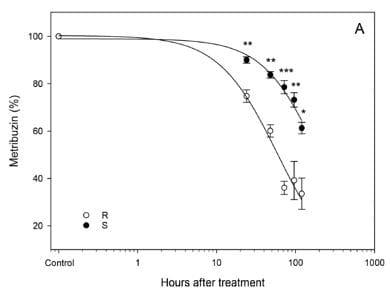MANY years ago, researchers from Harvard University asked people to watch a casual basketball game and count how many passes were made by the team wearing white shirts. If you haven’t seen it before take a quick look before you read on.
The experiment had nothing to do with counting or basketball. Instead it demonstrated how we miss much of what is going on around us. In this case only half the viewers noticed a gorilla walking through the middle of the game.
Today, AHRI PhD student Huan Lu is studying herbicide-resistant wild radish rather than people, but he still wants to make sure he doesn’t miss any gorillas.
What’s the story?
Huan Lu’s been investigating a population of wild radish that has the infamous Ser-264-gly mutation. This is the target-site mutation that is behind TT canola and makes wild radish highly resistant to PSII-inhibiting herbicides like atrazine and, to a lesser extent, metribuzin.
But, he wondered if there was more to this resistance than first meets the eye. Does focusing on the strong 264 mutation mean that we could fail to identify other important resistance mechanisms?
His study revealed a population of wild radish that had metabolic resistance to metribuzin as well as the 264 mutation. This is the first time that metabolic resistance has been identified in wild radish and this has implications for how we manage it.
Effectively, if we just focus on the 264 mutation, that metabolic gorilla is going to come back to bite us.
Different types of resistance
For those who like to put things in boxes, there are two broad groups of resistance – target-site resistance and non-target-site resistance.
Target-site resistance is often a mutation at the herbicide’s target site. The 264 mutation in the psbA gene prevents herbicide from binding to the chloroplast D1 protein.
Non-target-site resistance is any mechanism that reduces the amount of herbicide to a sublethal dose before it reaches the target site. This can include limiting herbicide uptake and translocation or breaking the herbicide down through metabolism.
Enhanced metabolism of PSII-inhibiting herbicides has been identified in several weed species including annual ryegrass, but it can be technically challenging to study and there is often a lower level of resistance than for target-site resistance.
What was the research?
Huan Lu collected metribuzin-resistant Wild Radish from the high-rainfall zone in the northern WA grain belt, a region where lupin-wheat rotations and the use of triazine herbicides are common. Gene sequencing showed that this resistant population contained the 264 mutation.
This is when he started to look for other resistance mechanisms.
Using 14C-labelled metribuzin Huan Lu followed the path of the herbicide through the Radish plants. Most herbicide-susceptible plant species have some level of ability to metabolise herbicides, but these resistant plants were able to metabolise metribuzin at double the rate of susceptible plants (Figure 1).
Figure 1. Metribuzin is metabolised twice as fast in the resistant wild radish plants (○) than in the susceptible plants (●).
Farmers and agronomists may be surprised to know that to our knowledge, this is the first time that metabolic resistance has been identified in wild radish. In fact, metabolic resistance has only been reported in a few broadleaf weeds to date and is far more common in grasses. But the reality is that most research is still focused on target-site resistance.
Metabolic resistance is not as strong as the 264 mutation but it still has a few tricks up its sleeve.
The 264 mutation is maternally inherited, in other words it is spread by seed, so the rate of spread depends on seed production. In contrast, metabolic resistance can also be spread by pollen, meaning it can potentially be spread more widely and more rapidly.
Other herbicides
Huan Lu also tested this population of wild radish against other herbicides and found it was also multiple-resistant to the ALS-inhibiting herbicides chlorsulfuron and imazapic + imazapyr, but not to the auxinic herbicide 2,4-D or the HPPD-inhibiting herbicide mesotrione.
This multiple-resistance was found to be target-site mutation based, but is also possible via metabolic resistance although not examined in the study.
What does that mean?
Metabolic resistance should not be overlooked. What it lacks in power it more than makes up for in numbers. And as we know weed control is a numbers game.
Low rates can select for metabolic resistance, particularly in weeds that are genetically diverse and cross-pollinating – just like wild radish.
Which brings us back to control. While target-site resistance is decisive, metabolic resistance is insidious. It can happen without us noticing. One minute a harmless basketball game, the next, a paddock full of gorillas.
Conclusion
To combat metabolic resistance, we need to use all the tools in the box. And the potential for multiple-resistance means that non-chemical tactics will be essential.
Take a moment to review The Big 6 and remember the best defence against gorillas is a strong tactical offence – and maybe a new pair of spectacles.
Paper
Source: Australian Herbicide Resistance Initiative (AHRI)





HAVE YOUR SAY